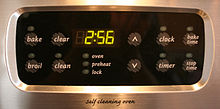Displays
To represent the time, most digital clocks use a seven-segment LED, VFD, or LCD display for each of four digits. They generally also include other elements to indicate whether the time is AM or PM, whether or not an alarm is set, and so on.Setting
If people find difficulty in setting the time in some designs of digital clocks in electronic devices where the clock is not a critical function, they may not be set at all, displaying the default after powered on, 00:00 or 12:00.[5][6]Digital clocks that run on mains electricity and have no battery must be reset every time the power is cut off or if they are moved. Even if power is cut off for a second, most clocks will still have to be reset. This is a particular problem with alarm clocks that have no "battery" backup, because even a very brief power outage during the night usually results in the clock failing to trigger the alarm in the morning.
To reduce the problem, many devices designed to operate on household electricity incorporate a battery backup to maintain the time during power outages and during times of disconnection from the power supply. More recently, some devices incorporate a method for automatically setting the time, such as using a broadcast radio time signal from an atomic clock, getting the time from an existing satellite television or computer connection, or by being set at the factory and then maintaining the time from then on with a quartz movement powered by an internal rechargeable battery.
Uses
- Because digital clocks can be very small and inexpensive devices that enhance the popularity of product designs, they are often incorporated into all kinds of devices such as cars, radios, televisions, microwave ovens, standard ovens, computers and cell phones. Sometimes their usefulness is disputed: a common complaint is that when time has to be set to Daylight Saving Time, many household clocks have to be readjusted. The incorporation of automatic synchronisation by a radio time signal is reducing this problem (see Radio clock).





No comments:
Post a Comment